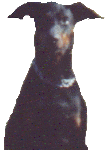OTHER
SIGNS (W)
|
 |
W1 'FOREWARNING SIGNAL HERE'
Indicates
the place the forewarning signal is set. Whenever
the line is provided with 4-way automatic block
control signals, W1 sign is conected with one
before last automatic signal, before main signal.
|
  |
W2 'SET OUT DIRECTION'
Indicates
the direction of junction leaving train. Usually
illuminated letter points the name of the
junction the train is leaving to. W2 sign is
illuminated only when the semaphore gives ride
allowance signal. (very rare sign)
|
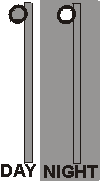 |
W3 'IGNORE THE SIGNAL'
W3 sign is
placed at the base signal set on the right side
of the track, whenever the base signal is not
connected with this track.
|
 |
W4 'TRAIN HEAD HERE'
W4 sign is
connected with passenger trains. It points the
place where the head (the locomotive) of the
train should be while stopping at the station or
passenger stop.
|
 |
W5 'SHUNTING BORDER'
Points the
border of the shunting. WIthout special
permission, shunting locomotive cannot go
further. Usually as a metal-late, not
illuminated.
|
 |
W6 'GIVE Rp1-SIGNAL [warning]'
Whenever
set, W6 sign orders to the loco-enginer giving
Rp1 sound-signal, warning around about closing
train.
|
 |
W6a 'GIVE Rp1-SIGNAL [warning]
BEFORE RAIL-ROAD CROSSING'
W5 sign
orders to the loco-enginer giving Rp1
sound-signal, warning would-be cars about
approaching to the rail-road crossing train.
|
 |
W7 'GIVE Rp1-SIGNAL [warning]
AT THE TRACK CONSTRUCTION'
W5 sign
orders to the loco-enginer giving Rp1
sound-signal, warning the workers at track
construction ahead.
|
 |
W8 'SPEED LIMIT AHEAD'
W8 sign
warns the loco-engineer about near-by permament
speed-limit (in tens of given number, here - 60
km/h). The limit borders are pointed by W9 signs.
Such limit (permament) is noted in special
internal brochure (called 'WOS' = 'wykaz
ostrzezen stalych', which means 'permament limits
list') and usually taken into account while
constructing the timetable.
|
 |
W9 'SPEED LIMIT BORDER'
The
beggining (left) and the end (right) of permament
speed limit.
|
 |
W10a 'BEGIN PUSHING'
If train
pushing is obligatory for the particular fragment
of the line, W10a sign gives the order to start
pushing in next 100 m (W10a is set 100m before).
|
 |
W10b 'STOP PUSHING'
W10b orders
to stop pushing the train and is set exactly at
the place where the pusher has to stop pushing.
|
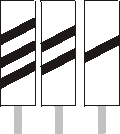  |
W11a 'FOREWARNING SIGNAL AHEAD'
W11a
(there're three separate signs) are placed every
100m (exceptionally the distance can be decreased
to 60m) from 3-stripped to 1-stripped sign before
forewarning signal, or the main semaphore (only
if the reflected signal is very difficult to see
because of the landscape conditions). The signs
can be rectangular-shaped or square-shaped, but
taking one, all three signs must consequently
keep the shape.
|
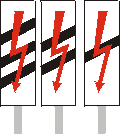  |
W11b 'FOREWARNING SIGNAL AHEAD -
ELECTRIFIED LINE STARTS'
W11b
(there're three separate signs) are placed every
100m (exceptionally the distance can be decreased
to 60m) from 3-stripped to 1-stripped sign before
forewarning signal of the station (or
manually-controlled block) on which the
electrified route starts. It means that one can
meet such signs while going the unelectrified
route and entering the electrified junction.
|
 |
W11p 'RAIL-ROAD CROSSING
FOREWARNING SIGNAL AHEAD'
W11p sign
is placed 200 m before RR-crossing forewarning
signal (Osp).
|
 |
W12 'WET THE ASH-BOX AND CLOSE
ITS COVER'
W12 sign
concerns steam locomotives and is placed 200 m
before bridges and viaducts. The activity of
wetting and closing the ash-box must be done at
the place the sign is set.
|
  |
W13 'LIFT UP THE KNIFES AND
CLOSE THE SIDE-WINGS OF THE SNOW-PLOUGH'
W13 sign
(left) concerns snow-ploughs and points the
places where snow-plough devices should be closed
to avoid its damage (rail-road crossings, bridge,
switch, any detector at the track). W13 sign is
placed 50 m before such place. W13 is valid for
any other service stock (like tamping machine,
etc.).
W13 sign - right image - is set when two on-route
obstacles are present within the distance of 150
m one from another.
|
 |
W14 'NON-PERMAMENT SPEED LIMIT
BORDER'
The
beggining (left) and the end (right) of
non-permament speed limit. These signs are always
connected with D6 sign presence before.
|
 |
W15 'SIGNAL ON THE WRONG SIDE OF
THE TRACK'
If the
local circumstances make the semaphore difficult
to set in the place it should be posted, the
semaphore can be placed on the other side of the
track, with regard to W15 sign, which must be set
at the place, the semaphore should be present.
The black triangle must point the semaphore set
on the other side (two possible ways, so two
possible images of this sign).
|
 |
W16 'PASSENGER STOP IN A
BRAKE-DISTANCE'
W16 sign is
set in a brake distance from passenger stop to
prepare the passenger train loco-engineer for
stop.
|
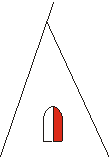 |
W17 'TRACK OCCUPANCY BORDER'
W17 sign
points the place at the track-junction, to which
the track can be occupied without collision to
the stock on the next track.
|
 |
W18 'FOREWARNING SIGNAL
EQUIVALENCY'
W18 sign is
mounted at the last automatic block control
semaphore before the main semaphore. By that,
this last automatic block control semaphore
becames the forewarning signal of the main
station semaphore.
|
 |
W19 'SHORT DISTANCE BETWEEN NEXT
TWO SIGNALS'
W19 sign
(illuminated together with ride allowance signal)
informs the distance between next two signals
(given by the semaphores or forewarning signal
and the semaphore) is smaller than estimated for
that line brake distance.
|
 |
W20 'SHORT DISTANCE TO NEXT
SIGNAL'
W20 sign
(on the main semaphore or the forewarning signal)
informs the distance to next semaphore is smaller
than estimated for that line brake distance.
|
 |
W21 'SIDE TRACK PASS SPEED LIMIT
THROUGH THE SWITCH'
W21 sign is
concerned only with Sr3 mechanical semaphore
signals (as one can reflect 40, 60 and 100 km/h
on the light-semaphore) and points the speed
limit (in tens of number reflected) in case of
Sr3 signal giving. According to the rules, Sr3 is
connected with 40 km/h always. In there's a
possibility of going through the switch with
greater than 40 km/h speed, the W21 sign is
illuminated.
|
 |
W22 'FREIGHT TRAIN CAN IGNORE S1
GIVEN ON AUTOMATIC BLOCK CONTROL SIGNAL'
W22 sign
let every heavy freight train ignore S1 signal
('stop') given by automatic block control
semaphore. W22 sign is set on main lines where
the gradient is greater than 6 o/oo.
The freight train may pass this semaphore with
limited to 15 km/h speed.
|
 |
W23 'BEGGINING OF THE INSULATED
TRACK/SWITCH SECTION'
W23 signs
the place, the shunted stock should be stopped
before, to make the ability of remote switch
change.
|
 |
W24 'ENTERING THE WRONG TRACK OF
TWO-TRACK ROUTE'
Usually
illuminated together with ride allowance signal
or together with 'Sz' signal (substituting
signal), whenever the train enters the wrong
track of two-track line.
|
 |
W25 'ELECTRIC HEATING OF THE
CARS'
Numbers and
horizontal arrows point the track. When
illuminated, the electric heating is on (no
entry). Sign image presented here is connected
with two tracks provided with electric heating
devices.
|
 |
W26a 'ENTERING THE COMMUTER TRAIN
TRACK'
Illuminated
together with ride allowance signal, if the train
will pass from main state line to commuter train
line ('P' = podmiejski, in Polish).
|
 |
W26b 'ENTERING THE MAIN STATE
LINE TRACK'
Illuminated
together with ride allowance signal, if the train
will pass from commuter train line track to a
main state line track ('D' = dalekobiezny,
in Polish)..
|
 |
W27 'NEW MAXIMUM ROUTE SPEED'
W27 sign is
set at every place the route speed changes. New
maximum route speed is written in tens of km/h
(in presented example the new maximum route speed
is 120 km/h). Note: the maximum train speed is
defined in internal train schedule and the train
cannot proceed with the speed greater from
indicated by W27 sign.
|
 |
W28 'TRAIN RADIO-COMMUNICATION
CHANNEL CHANGE'
W28 signs
the place of train radio-communication channel
change. The new channel is defined by the number
shown on the sign.
|
 |
W29 'CONNECT TO LINE TRAFFIC
CONTROLLER'
W29 signs
are used on few lines in Poland, on which the
radio-remote traffic controlling was introduced.
W29 sign is set usually 1600 m before the
remote-controlled trainpass and orders the
loco-engineer contacting the line traffic
controller.
|
 |
W30 'SPEED RANGE WHILE PASSING
THE WEIGHBRIDGE'
W30 orders
to keep the speed within written range, while
passing the weighting device.
|
 |
W31 'THE IMAGE OF THE SIGNAL IS
NOT VALID'
W31 (white
cross) is put onto the signal that has been
canceled or is not yet valid.
|
 |
W32 'xxx m LONG PASSENGER TRAIN
HEAD HERE'
W32 is put
on the passenger stops and stations, to mark the
place, where the head of the train should stop,
if the train length (50 m grade on the sign) is
close to the number shown on the sign.
|
